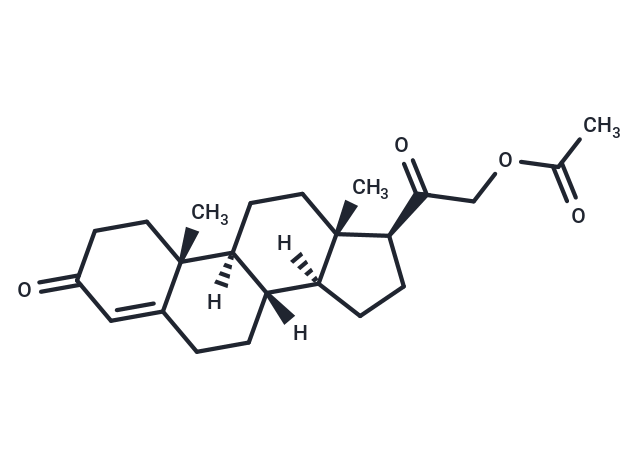Shopping Cart
Remove All Your shopping cart is currently empty
Your shopping cart is currently empty
Deoxycorticosterone acetate (DOCA) is a steroid hormone produced by the adrenal glands, possessing mineralocorticoid activity and serving as a precursor to aldosterone. As an agonist of the mineralocorticoid receptor, DOCA can induce severe kidney damage, including inflammation, fibrosis, glomerular injury, and proteinuria. It is commonly used to establish animal models of chronic kidney injury and hypertension.

| Pack Size | Price | USA Warehouse | Global Warehouse | Quantity |
|---|---|---|---|---|
| 50 mg | $30 | In Stock | In Stock | |
| 100 mg | $40 | In Stock | In Stock | |
| 500 mg | $81 | In Stock | In Stock | |
| 1 g | $129 | - | In Stock | |
| 1 mL x 10 mM (in DMSO) | $44 | In Stock | In Stock |
| Description | Deoxycorticosterone acetate (DOCA) is a steroid hormone produced by the adrenal glands, possessing mineralocorticoid activity and serving as a precursor to aldosterone. As an agonist of the mineralocorticoid receptor, DOCA can induce severe kidney damage, including inflammation, fibrosis, glomerular injury, and proteinuria. It is commonly used to establish animal models of chronic kidney injury and hypertension. |
| Kinase Assay | Kinase inhibition: The ability of compounds to inhibit ATR, ATM or DNAPK kinase activity istested using a radiometric-phosphate incorporation assay. A stock solution isprepared consisting of the appropriate buffer, kinase, and target peptide. To this isadded the compound of interest, at varying concentrations in DMSO to a final DMSO concentration of 7%. Assays are initiated by addition of an appropriate [γ-33P]ATP solution and incubated at 25 ℃. Assays are stopped, after the desired time course, by addition of phosphoric acid and ATP to a final concentration of 100 mM and 0.66 μM, respectively. Peptides are captured on a phosphocellulose membrane, prepared as per manufacturer's instructions, and washed six times with 200 μL of 100 mM phosphoric acid, prior to the addition of 100 μL of scintillation cocktail and scintillation counting on a 1450 Microbeta Liquid Scintillation Counter. Dose?response data are analyzed using GraphPad Prism software |
| Synonyms | DOC acetate, Cortexone acetate, 11-Deoxycorticosterone acetate |
| Molecular Weight | 372.50 |
| Formula | C23H32O4 |
| Cas No. | 56-47-3 |
| Smiles | [H][C@@]12CC[C@H](C(=O)COC(C)=O)[C@@]1(C)CC[C@@]1([H])[C@@]2([H])CCC2=CC(=O)CC[C@]12C |
| Relative Density. | 1.0415 g/cm3 (Estimated) |
| Storage | keep away from direct sunlight | Powder: -20°C for 3 years | In solvent: -80°C for 1 year | Shipping with blue ice/Shipping at ambient temperature. | |||||||||||||||||||||||||
| Solubility Information | DMSO: 13.47 mg/mL (36.16 mM), Sonication is recommended. Ethanol: 12.5 mg/mL (33.56 mM), Sonication is recommended. H2O: < 1 mg/mL (insoluble or slightly soluble) | |||||||||||||||||||||||||
| In Vivo Formulation | 10% DMSO+40% PEG300+5% Tween 80+45% Saline: 1 mg/mL (2.68 mM), Sonication is recommended. Please add the solvents sequentially, clarifying the solution as much as possible before adding the next one. Dissolve by heating and/or sonication if necessary. Working solution is recommended to be prepared and used immediately. The formulation provided above is for reference purposes only. In vivo formulations may vary and should be modified based on specific experimental conditions. | |||||||||||||||||||||||||
Solution Preparation Table | ||||||||||||||||||||||||||
Ethanol/DMSO
| ||||||||||||||||||||||||||
| Size | Quantity | Unit Price | Amount | Operation |
|---|

Copyright © 2015-2025 TargetMol Chemicals Inc. All Rights Reserved.